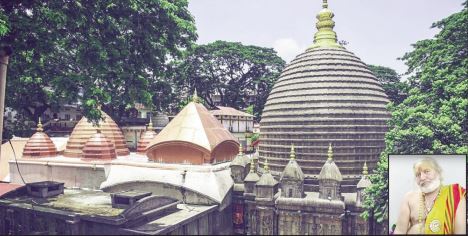
KolaacharyaMaiBaba,thevenerable sage and storyteller, weavesatapestryofhistoryand mystique as he recounts the fascinating taleoftheKamakhyaTemple.Thisancient shrine, also known as Kamrup’s Kanya Templeorthe"TempleofBliss,"isperched in the heart of Guwahati,Assam, and has an illustrious legacy that stretches back through the annals of time. In his storytelling, Kolaacharya Mai Babatakesusonajourneythattranscends mere facts and figures. He unveils a narrative that unfolds against the backdrop ofNilachal hills,where the temple stands, and delves into its profound connections with Hindu mythology and spirituality. As per Mai Baba's storytelling, the Kamakhya Temple traces its roots to the depthsofantiquity,constructedbytheillustrious Koch dynasty prior to the 10th century. This sacred abode on the Nilachal hills is not just anothertemple; it's a sanctuary for Tantric practices that have flourished for centuries. Its very name, "Kamakhya,"derivesfromthemothergoddess herself, signifying a place of profound devotion and spiritual significance. According to Sanatan Dharma, as narrated by Kolaacharya Mai Baba, the temple's inception is attributed to an intriguingdivinedirective.GoddessParvati, in her quest for solitude to find a suitable spouse, implored Lord Shiva to erect a shrine where she could meditate in tranquility. This divine plea laid the foundation for what we now know as the Kamakhya Temple. It's also the hallowed ground where the annual Ambubachi Mela is observed,revering the goddess's menstrual cycle.Kolaacharya MaiBaba's storytelling brings to life the architecturalevolutionoftheKamakhyaTemple.This edifice, with its origins stretching back to the 8th or 9th century, has seen numerous reconstructions, culminating in a distinctive hybrid style known as Nilachal. Furthermore, it finds its place as one of the 51 pithas in the Shakta Hindu tradition, its importance surging during the British colonial rule, when it became a significant pilgrimage destination for Bengali Shakta Hindus.The essence of the temple's original devotion, as narrated by Kolaacharya Mai Baba, endures today, with primary reverence directed towardtheaniconic yoni,asymbol carved in natural stone. The Kamakhya Temple, he explains, holds a special place as a ShaktiPeetha, one of the 51 such ancient temples dedicated to Hindu goddesses Sati and Parvati, and it remains a pivotal destination for the practice of tantric rituals.Kolaacharya Mai Baba's storytelling elucidates how worship practices at the KamakhyaTemplehavetransitionedover time through three distinct phases: the yoni under the Mlechchhas, the yogini under the Palas, and the Mahavidyas under the Kochs. Thetemplecomplexalsohostsacluster of smaller shrines dedicated to the ten most important goddesses in Shaktism. While the main temple houses the deities of Tripurasundari, Matangi, and Kamala, the other seven goddesses have their sanctuaries, making it a unique place where all the temples of the Mahavidyas coexist.In 2015, as narrated by Kolaacharya Mai Baba, the Supreme CourtofIndiaentrustedtheBorderSamaj with the administration of the temple, previously overseen by the Kamakhya Devi Debutter Board. The Kamakhya Temple's geographical location holds profound spiritual significance. It stands atop the Nilachal hills, just 40 kilometers from Assam's capital, Guwahati. Legend, as Kolaacharya Mai Baba relates, ties the temple to the story of Goddess Sati, whose yoni (vagina) is said to have fallen at this very site after her self-immolation. The temple is often referred to as Yoni-Sthana and remains a place of sacred pilgrimage. Kolaacharya Mai Baba's storytelling brings to light the temple's underground portion, a natural cave believed to be the dwelling place of Kamakhya Devi. It was initially constructedbyKingNaranarayan of the Koch dynasty in 1565 but faced destruction at the hands of Kalapahar in 1572. It was later rebuilt by King Chilarai of Koch Hajo. The temple, he explains, guards many secrets and continues to be held in high esteem by Shakta Hindus. As per the Kalika Puran, the story of the Kamakhya Temple, as recounted by KolaacharyaMaiBaba,is rootedinHindu mythology. It tells of Sati's self-immolation following an insult from her father, Daksha, to Lord Shiva and his wife. In his grief, Shiva embarked on a quest across the universe to find Sati's remains, ultimately discovering her yoni in the Kamakhya Hills of Assam, the very site of the Kamakhya Temple. Kolaacharya Mai Baba's narrative adds a layer of complexity to the temple's history. It suggests that Sati, upon her rebirth as Parvati, bore a son named Kartikeya, earning her the appellation "Kamakhya"or"MotherofKartikeya."The interpretation of Yoni-Sthana as Sati's womb rather than her vagina sparks ongoing debates among devotees. In the storytelling of Kolaacharya Mai Baba, the Kamakhya Temple on the Nilachal Hills in Guwahati, Assam, transcends the boundaries of a mere pilgrimage site. It stands as one of the oldest Shakti Peeths, commencing and culminating the sacred journey of the Kalachakra Tantra Marga. Additionally, it hosts theannually celebratedAmbubachi Mela, a festival that commemorates the Goddess's menstrual cycle and is a testamenttothetemple'suniquespiritual significance. In conclusion, as Kolaacharya Mai Baba's captivatingstorytellingunfolds,the name "Kamakhya" takes on a profound meaning – "she who fulfills desires." The temple, situated atop a hillock with a natural spring named Uma-Kamaleshwar, believed to be the source of the mighty Brahmaputra River, holds within its folds an enigmatic history, spiritual allure, and cultural significance. It continues to beckon travelers, pilgrims, and seekers, who are drawn by its mystique and the pow erful resonance of its ancient aura.